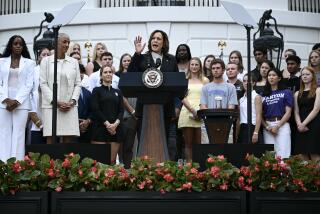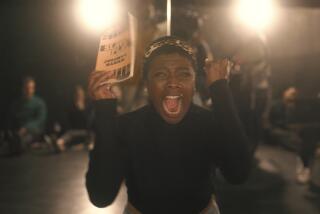Strikingly good vibes from Stefon Harris
- Share via
The vibraphone has always been an enigmatic jazz instrument for me. Although I’ve been mesmerized by the very different styles of Lionel Hampton, Red Norvo, Terry Gibbs, Bobby Hutcherson and Milt Jackson -- to name a few -- I have often found the instrument’s plink-plunk, in other hands, to be less than beguiling.
I added Stefon Harris to that list of mesmerizing players almost as soon as I heard him. And each subsequent encounter with his playing further justified my belief in his capacity to wring extraordinary sound and substance from this seemingly rigid assemblage of metal, wood and wires.
Harris’ performance Friday at the Jazz Bakery was a further revelation. Touring in support of his new album, “African Tarantella: Dances With Duke,” Harris led an impressive unit -- alto saxophonist Casey Benjamin, pianist Marc Cary, bassist Earl Travis and drummer Terreon Gully. The music was equally compelling, a combination of relatively obscure Duke Ellington material from “The New Orleans Suite” and “The Queens Suite” and his own intriguing works.
Harris was a generous leader, allocating substantial upfront opportunities to each of the other players, with Benjamin offering some horn-scouring improvisations, Cary balancing brilliant accompaniment passages with an idiosyncratic solo style and Gully creating a whirlwind of rhythm. Benjamin and Cary, in particular, displayed post-20th-century overviews -- tossing in bits and pieces of jazz memorabilia from Thelonious Monk and Ornette Coleman -- in their otherwise strikingly contemporary perspectives.
For the first half of the set, Harris’ generosity seemed to come at the cost of his own presence. When he finally did get around to claiming his role as the showcase artist, he did so masterfully. Playing vibraphone and marimba, he mixed the timbres of the two instruments, often using four mallets, skimming across the metal and wood bars with zephyr-like ease.
In one impressive cadenza-like passage, he was astonishing -- moving through quick-time passages with eye-blurring rapidity, suddenly altering the space and time flow of his improvisation with interval-leaping starts and stops, somehow managing to do it all with a propulsive sense of swing.
I still have reservations about the vibes. But not about Harris, who would be an irresistibly fascinating artist even if he were playing, say, the accordion.
More to Read
The biggest entertainment stories
Get our big stories about Hollywood, film, television, music, arts, culture and more right in your inbox as soon as they publish.
You may occasionally receive promotional content from the Los Angeles Times.










